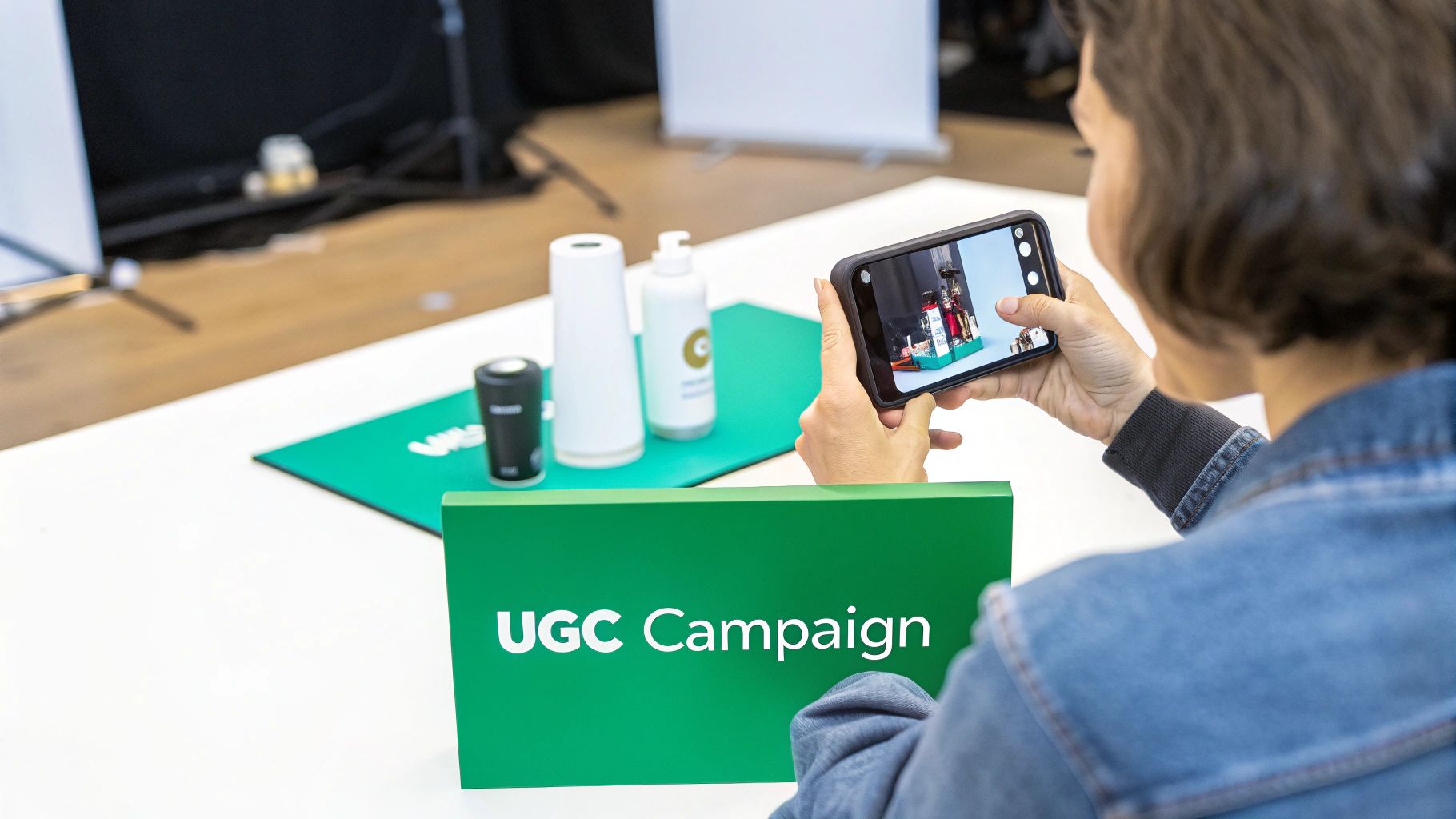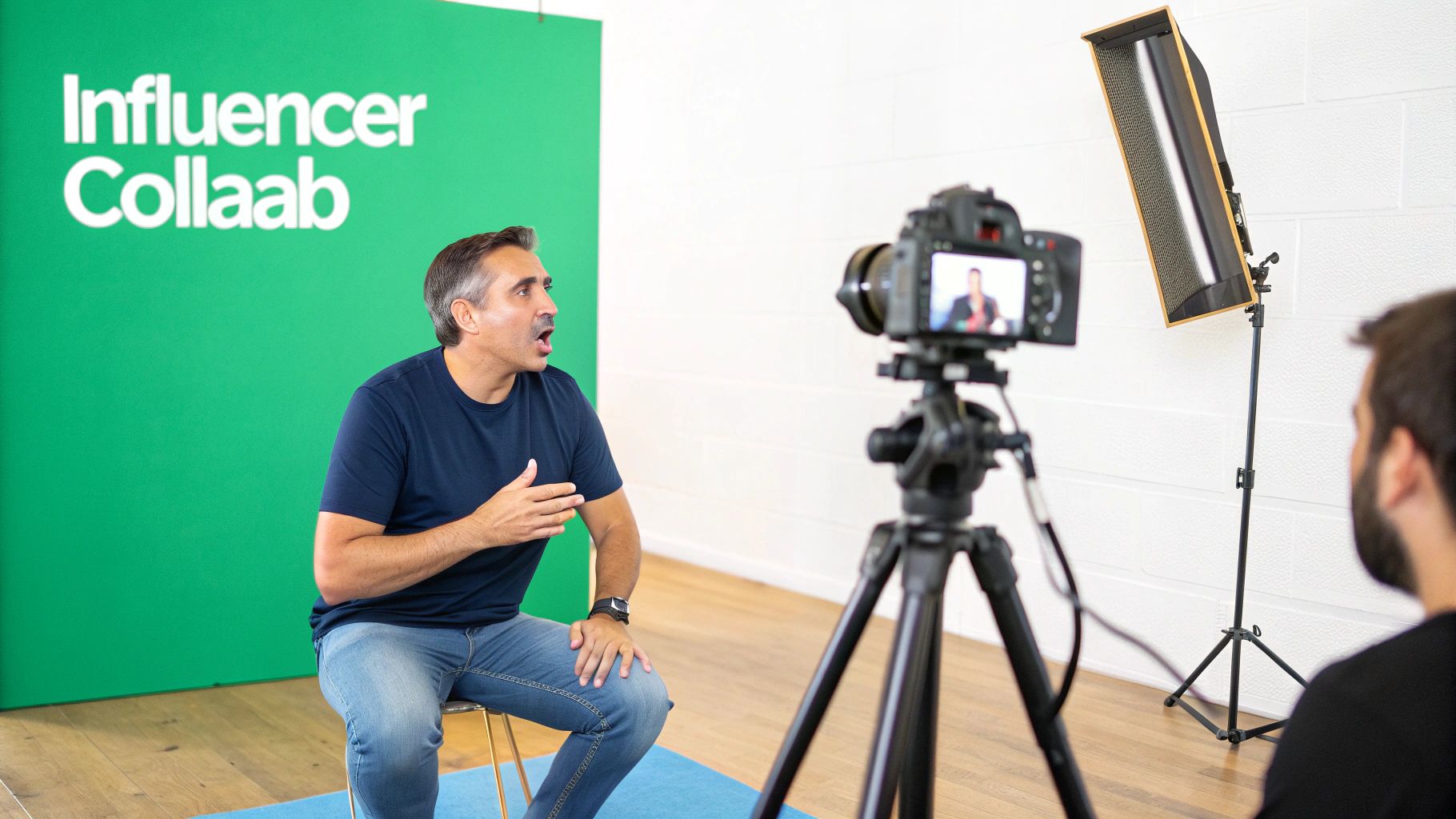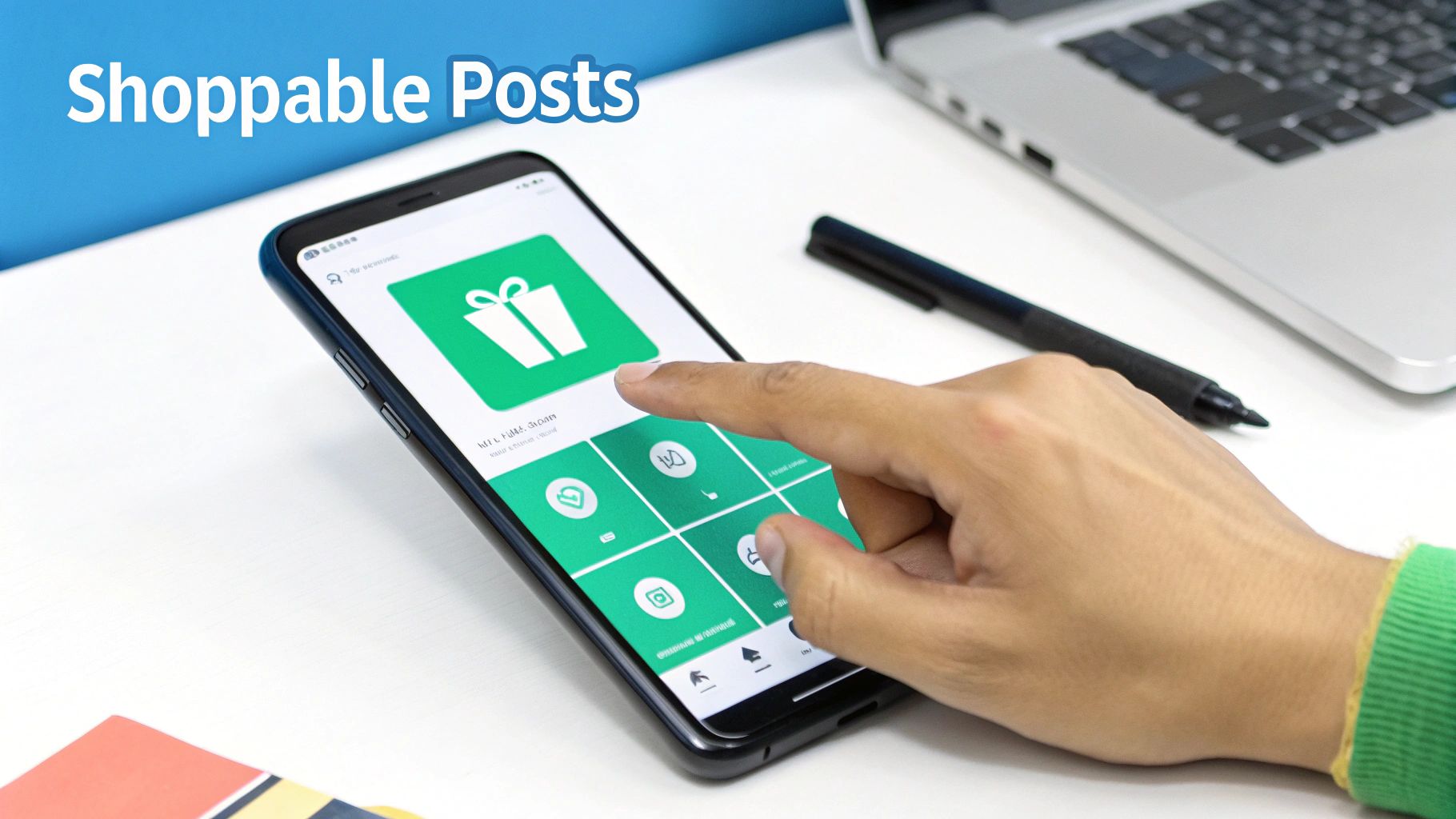9 Actionable Social Media Marketing Ideas for 2025
In a crowded online space, a stale social media strategy is a silent one. To effectively capture attention, drive meaningful engagement, and produce tangible business results, modern marketers require more than just a posting schedule. Go-to-Market (GTM) teams, ambitious solopreneurs, and small to medium business (SMB) marketers need a playbook of fresh, actionable social media marketing ideas that resonate with today's sophisticated audiences.
This article cuts through the noise and delivers a curated collection of nine powerful strategies designed to give you a distinct competitive advantage. Forget generic advice; we are diving deep into the practical application of concepts that build brands and convert followers into customers. You will find specific implementation details, real-world examples, and unique angles you can put into action immediately.
Whether you're a solopreneur aiming for high-intent leads, a marketing team looking to boost brand sentiment, or a sales organization seeking to enhance outreach, this guide provides the tools you need. We'll explore everything from harnessing user-generated content and building vibrant communities to leveraging social commerce and personalized advertising. Prepare to move beyond basic social media management and learn how to craft a dynamic, high-impact presence that achieves your most critical marketing objectives.
1. User-Generated Content (UGC) Campaigns
User-generated content (UGC) campaigns are a powerful social media marketing idea that flips the traditional content model. Instead of your brand creating all the content, you empower your audience to become your storytellers. This strategy involves encouraging customers to create and share photos, videos, and stories featuring your products or services, which you then highlight on your own channels. The result is a wealth of authentic, relatable content that acts as powerful social proof.

This approach thrives on authenticity. Modern consumers trust recommendations from peers far more than branded advertisements. By featuring real customers using your products in real-life scenarios, you build a level of trust and credibility that is difficult to replicate with polished, professional shoots. It also fosters a strong sense of community, making customers feel valued and part of your brand's journey.
How to Implement a UGC Campaign
A successful UGC campaign is more than just asking for photos. It requires a clear strategy to motivate and guide your audience.
- Create a Unique Hashtag: Develop a simple, memorable, and unique hashtag for your campaign. This makes it easy to track submissions and creates a searchable gallery of content. Think of GoPro's iconic #GoPro hashtag, which curates millions of adventure-focused visuals.
- Offer Clear Incentives: Motivate participation by offering something valuable. This could be a contest with a grand prize, a discount code for future purchases, or the chance to be featured prominently on your brand's social media profiles or website.
- Set Clear Guidelines: Avoid confusion by providing simple rules. Specify the type of content you're looking for, mention the campaign hashtag, and state any deadlines or requirements. Transparency is key.
- Promote and Engage: Announce your campaign across all your channels: email, social media bios, and posts. As content rolls in, actively engage with it. Like, comment on, and share submissions to show appreciation and encourage more participation. Always credit the original creator.
2. Influencer Partnerships and Collaborations
Influencer partnerships are a strategic social media marketing idea that involves collaborating with individuals who have a dedicated and engaged following. Instead of broadcasting your message directly, you leverage the trust and credibility an influencer has built with their audience. This approach allows your brand to tap into niche communities and reach highly targeted demographics through authentic, personality-driven endorsements.

This strategy works because it mimics word-of-mouth marketing on a digital scale. Recommendations from a trusted creator feel more genuine than a traditional advertisement, cutting through the noise of crowded social feeds. By partnering with the right influencer, you can introduce your product to a warm audience that is already receptive to their advice, leading to higher engagement and conversion rates. It’s a powerful way to build brand awareness and drive sales through a trusted voice.
How to Implement an Influencer Partnership
A successful influencer collaboration goes beyond simply paying for a post. It requires careful planning, alignment, and a focus on building genuine relationships.
- Identify the Right Partners: Focus on relevance over reach. Choose influencers whose audience demographics and values align perfectly with your target customer. Prioritize their engagement rate over their follower count, as a smaller, more dedicated community often yields better results. For example, a sustainable fashion brand would benefit more from a partnership with a micro-influencer focused on ethical living than a mainstream celebrity.
- Set Clear Goals and Expectations: Define what you want to achieve. Are you aiming for brand awareness, lead generation, or direct sales? Communicate your goals, key messages, and deliverables clearly, but allow the influencer creative freedom to produce content that feels authentic to their style.
- Establish a Mutually Beneficial Arrangement: Compensation can range from free products and affiliate commissions to flat fees. Structure a deal that is fair and motivating for the influencer, encouraging them to become a true brand advocate.
- Track and Measure Performance: Use unique discount codes, affiliate links, or UTM parameters to track the traffic and sales generated from the campaign. This data is crucial for measuring your return on investment and refining your future influencer marketing ideas.
3. Live Streaming and Interactive Content
Live streaming and interactive content are social media marketing ideas that leverage real-time video to forge a direct, unedited connection with your audience. This strategy involves broadcasting live on platforms like Instagram, Facebook, LinkedIn, or TikTok to engage viewers with Q&As, product demonstrations, behind-the-scenes tours, or expert interviews. It creates an immediate, authentic experience that static posts cannot replicate, fostering a sense of urgency and community.

This approach capitalizes on the "fear of missing out" (FOMO), as viewers must tune in live to participate. The raw, unfiltered nature of live video builds significant trust, showing the human side of your brand. It’s a powerful tool for boosting engagement rates, as platforms often prioritize live content in user feeds and send notifications to followers when you go live. Brands like Sephora use it for live makeup tutorials, while LinkedIn Live has become a staple for B2B thought leadership.
How to Implement Live Streaming
A successful live stream is well-planned but leaves room for genuine interaction. It requires more than just hitting the "go live" button.
- Promote Your Session in Advance: Generate buzz by announcing your live event across all channels. Use countdown stickers on Instagram Stories and create event pages on Facebook or LinkedIn to remind your audience to join.
- Prepare Key Talking Points: Have a clear outline of what you want to cover to stay on track, but be flexible enough to engage with the audience's questions and comments. Spontaneity is part of the appeal.
- Engage with Viewers in Real-Time: The magic of live video is interaction. Acknowledge viewers by name, answer their questions as they come in, and respond to comments. This makes your audience feel seen and valued.
- Test Your Technology: Before going live, check your internet connection, audio, and video quality. A poor technical setup can quickly cause viewers to drop off.
- Repurpose Your Content: After the stream ends, save the video. You can repurpose it into shorter clips for other platforms, a blog post summary, or a podcast episode, extending the life of your content.
4. Social Commerce and Shoppable Posts
Social commerce is a transformative social media marketing idea that closes the gap between discovery and purchase. It involves integrating e-commerce functionality directly into social media platforms, allowing users to browse and buy products without ever leaving the app. This strategy streamlines the customer journey, turning passive scrolling into an active shopping experience and capitalizing on impulse-buy moments.

This approach significantly reduces friction, as customers can move from inspiration to checkout in just a few taps. By making purchasing as easy as liking a post, brands can capture high-intent customers at the peak of their interest. Platforms like Instagram, Facebook, TikTok, and Pinterest have become powerful sales channels, used effectively by fashion brands like Zara, beauty retailers like Fenty Beauty, and countless small businesses.
How to Implement Social Commerce
Building a seamless shoppable experience requires more than just enabling a feature; it demands a thoughtful and visually compelling strategy.
- Optimize Product Visuals: Your product photos and videos are your virtual storefront. Ensure they are high-quality, visually appealing, and optimized for the vertical format of mobile feeds. Use a mix of polished studio shots, lifestyle images, and video demonstrations.
- Write Compelling Product Descriptions: Keep descriptions concise, engaging, and mobile-friendly. Highlight key benefits and use persuasive language that resonates with your target audience. Include all essential information, like materials or dimensions, to reduce purchase uncertainty.
- Create Themed Collections and Catalogs: Group products into curated collections or catalogs within your social shop. This could be based on seasons, trends, or specific use cases, making it easier for customers to discover related items and encouraging larger purchases.
- Leverage In-App Shopping Features: Utilize platform-specific tools like product tags in posts and stories, live shopping events, and dedicated shop tabs. Brands like Glossier excel at using Instagram's features to create an integrated and immersive shopping environment that feels native to the platform.
5. Community Building and Social Groups
Community building is a social media marketing idea that shifts the focus from broadcasting messages to fostering connections. Instead of just acquiring followers, this strategy involves creating dedicated online spaces, like Facebook Groups or private forums, where your audience can connect with each other and your brand. These groups become hubs for shared interests, support, and exclusive content, transforming customers into a loyal community.
This approach creates immense value beyond simple marketing. By nurturing a dedicated space, you build deep-rooted loyalty and a powerful feedback loop. Members feel a sense of belonging, making them more likely to become brand advocates. For example, Peloton's official Facebook group gives members a place to share workout milestones and encouragement, directly strengthening their connection to the brand.
How to Implement Community Building
Building a thriving community requires more than just creating a group. It demands active participation and a commitment to providing value to its members.
- Establish Clear Guidelines: Set the tone from the start with a clear code of conduct. Outline rules for self-promotion, respectful communication, and off-topic content. This ensures the space remains a positive and valuable resource for everyone.
- Share Exclusive Content: Make your group the go-to place for special access. Offer members first looks at new products, behind-the-scenes content, exclusive Q&As with team members, or group-only discounts. This incentivizes joining and staying active.
- Actively Participate and Engage: A community manager or brand representative should be present and active. Ask questions, start conversations, respond to comments, and facilitate discussions. Your presence shows that you value the community and are listening.
- Recognize and Celebrate Members: Spotlight active participants and their contributions. Feature user-submitted stories, celebrate their achievements, or create "member of the week" shout-outs. This reinforces a sense of value and encourages continued engagement.
6. Video Content Marketing
Video content marketing is a dynamic social media marketing idea that leverages the power of moving images to captivate audiences and communicate brand messages. Rather than relying solely on static images and text, this strategy involves creating and distributing various video formats, from short, engaging clips for platforms like TikTok and Instagram Reels to in-depth tutorials on YouTube or professional insights on LinkedIn. The goal is to tell compelling stories, educate viewers, and drive conversions through a highly engaging medium.
This approach is effective because video commands attention in a crowded feed and conveys emotion and information more efficiently than other content types. A well-crafted video can stop a user from scrolling, explain a complex product in seconds, and build a stronger connection with the viewer. From Dollar Shave Club's legendary viral launch video to countless brands using TikTok challenges, video has proven its ability to build brand personality and drive massive engagement.
How to Implement Video Content Marketing
A successful video strategy requires more than just hitting the record button. It demands careful planning, from concept to distribution, to ensure it resonates with your target audience.
- Hook Viewers Immediately: The first three seconds are critical. Start with a compelling question, a surprising visual, or a bold statement to capture attention before users scroll away. Your opening must promise value and intrigue.
- Optimize for Each Platform: Don't use a one-size-fits-all approach. Customize video dimensions (e.g., vertical for Reels, horizontal for YouTube), length, and style for each social media platform. A polished B2B video on LinkedIn will differ greatly from a trending audio clip on TikTok.
- Include Captions: A large portion of social media videos are watched without sound. Adding captions makes your content accessible to a wider audience, including those with hearing impairments, and ensures your message is understood in any viewing environment.
- Maintain Brand Consistency: Use consistent branding elements like logos, color palettes, and fonts across all your videos. This reinforces brand recognition and creates a cohesive, professional look for your social media presence.
- Analyze and Refine: Track key performance metrics like view duration, click-through rate, and engagement. Use these insights to understand what resonates with your audience and refine your video strategy for better results.
7. Personalized Social Media Advertising
Personalized social media advertising moves beyond generic, one-size-fits-all campaigns. This powerful social media marketing idea uses advanced audience segmentation, behavioral data, and AI to deliver highly relevant ads to specific user groups. Instead of broadcasting a single message to everyone, you tailor your content, creative, and offers to the unique interests, demographics, and online activities of different segments, dramatically increasing your ad spend's efficiency.
This strategy works because it respects the user's individuality. When an ad speaks directly to a person's needs or interests-like Amazon showing you a product you just viewed-it feels less like an interruption and more like a helpful recommendation. This level of relevance builds a stronger connection, drives higher engagement, and ultimately leads to better conversion rates. It is the difference between shouting into a crowd and having a meaningful one-on-one conversation.
How to Implement Personalized Social Media Advertising
Effective personalization requires a data-driven approach and a deep understanding of your audience. Here’s how to get started.
- Create Detailed Buyer Personas: Go beyond basic demographics. Build detailed profiles of your ideal customers, including their pain points, goals, hobbies, and online behavior. Use these personas to create hyper-targeted audience segments on platforms like Meta and LinkedIn.
- Leverage Retargeting and Custom Audiences: Use tracking pixels to build audiences based on specific actions, such as website visits, video views, or abandoned carts. You can also upload customer email lists to create Custom Audiences, allowing you to re-engage existing leads or upsell current customers.
- Test Different Ad Formats and Creative: Tailor your visuals and copy for each segment. A younger audience on Instagram might respond better to a Reel, while a professional audience on LinkedIn may prefer a carousel ad detailing a case study. Continuously test different formats to see what resonates.
- Set Up Robust Conversion Tracking: Ensure your tracking is configured correctly to measure key actions like purchases, form submissions, or downloads. This data is crucial for optimizing your campaigns and proving ROI. Platforms like Meta and Google provide the tools to monitor the entire customer journey.
8. Storytelling and Brand Narrative
Storytelling is a powerful social media marketing idea that moves beyond promoting products to creating an emotional connection with your audience. Instead of just listing features, this strategy involves weaving a compelling narrative around your brand’s mission, values, and personality. It transforms your brand from a faceless entity into a relatable character that your audience can connect with and support. The result is a loyal community that is invested in your journey, not just your products.

This approach capitalizes on the human desire for connection and meaning. Consumers are increasingly drawn to brands that stand for something more than profit. By sharing authentic stories, whether it's about your founder's journey, your commitment to a cause like Patagonia's environmental activism, or the real experiences of your customers, you build deep-seated loyalty. This narrative becomes your unique differentiator in a crowded market, fostering a strong brand identity that resonates on an emotional level.
How to Implement Storytelling and Brand Narrative
Building a strong brand narrative requires introspection and a consistent, multi-channel approach to communicating your core story.
- Define Your Core Narrative: Start by identifying what makes your brand unique. What is your origin story, your mission, or your core values? Condense this into a clear, compelling narrative that can be adapted across different platforms.
- Use Visuals to Enhance the Story: A picture is worth a thousand words, and video is worth even more. Use high-quality images, graphics, and videos to bring your narrative to life. Show, don't just tell, your brand's story.
- Showcase Authentic Experiences: Incorporate customer testimonials, employee spotlights, and behind-the-scenes content. These stories add authenticity and relatability, making your brand narrative more believable and impactful. Airbnb excels at this by sharing stories of hosts and guests.
- Maintain Consistency: Ensure your brand story is consistent across all your social media channels, website, and marketing materials. This consistency reinforces your identity and builds a cohesive, memorable brand experience for your audience.
9. Social Listening and Engagement Strategy
A social listening and engagement strategy transforms your social media channels from broadcast platforms into dynamic two-way communication tools. This practice involves actively monitoring social media for mentions of your brand, competitors, products, and industry-specific keywords. By tuning into these conversations, you gain unfiltered insights into audience sentiment, identify emerging trends, and can address customer needs in real time, turning reactive problem-solving into proactive community management.
This approach builds a brand that is seen as attentive, responsive, and human. When customers see you actively engaging with feedback, both positive and negative, it builds immense trust and loyalty. It also provides invaluable data for other business functions, from product development to content creation. Brands like Wendy's have mastered this with their witty and real-time Twitter engagement, while companies like JetBlue use it to deliver exceptional customer service, often resolving issues before they escalate.
How to Implement a Social Listening and Engagement Strategy
Effective social listening is more than just searching your brand name. It requires a structured process to capture and act on valuable conversations.
- Set Up Alerts and Monitoring: Use social media management tools to set up alerts for your brand name (including common misspellings), key executives, campaign hashtags, and competitor names. This ensures you never miss a relevant conversation.
- Respond Quickly and Authentically: Speed is crucial, especially for customer inquiries or complaints. Aim to acknowledge mentions promptly. Train your team on brand voice and response protocols to ensure every interaction is consistent and authentic, not robotic.
- Engage with Positive Mentions: Don't just focus on damage control. Actively celebrate and amplify positive mentions. Thank customers for their feedback, share their posts (with permission), and make them feel seen. This encourages more positive user-generated content.
- Use Insights to Inform Strategy: Regularly analyze the data collected. Are customers requesting a new feature? Are they confused about your pricing? Use these insights to refine your marketing messages, improve your products, and create more relevant content. For a deeper dive, explore how to enhance your brand's image with social media reputation monitoring.
Social Media Marketing Ideas Comparison
| Strategy | Implementation Complexity 🔄 | Resource Requirements ⚡ | Expected Outcomes 📊 | Ideal Use Cases 💡 | Key Advantages ⭐ |
|---|---|---|---|---|---|
| User-Generated Content (UGC) Campaigns | Medium: Needs active community management and moderation | Low to Medium: Leverages customers for content | Increased engagement, organic brand awareness, authentic social proof | Brands aiming for organic growth and emotional connection | High engagement, cost-effective, authentic content |
| Influencer Partnerships and Collaborations | High: Involves selecting and managing influencer relationships | Medium to High: Budget depends on influencer tier | Access to targeted audiences, measurable ROI, increased credibility | Targeted campaigns needing reach and trusted endorsements | Access to engaged audiences, credible content |
| Live Streaming and Interactive Content | Medium to High: Requires scheduling, tech setup, live management | Medium: Equipment and preparation needed | Immediate engagement, higher organic reach, audience insights | Real-time interaction, product demos, event coverage | Authentic connections, instant feedback |
| Social Commerce and Shoppable Posts | Medium: Setup of catalogs and product tagging | Medium: Product catalog management and platform fees | Higher conversion rates, impulse buys, seamless purchase flow | Brands focusing on direct sales through social platforms | Reduces purchase friction, detailed analytics |
| Community Building and Social Groups | High: Continuous management and engagement required | Medium: Staff and content creation for engagement | Strong loyalty, customer insights, peer support, brand authority | Building long-term relationships and loyal customer base | High loyalty, customer feedback, word-of-mouth |
| Video Content Marketing | High: Requires production skills and editing | High: Equipment, editing, and creative time | High engagement, emotional connection, viral potential | Storytelling, product demos, educational content | Highest engagement, shares easily |
| Personalized Social Media Advertising | High: Complex targeting and campaign optimization | Medium to High: Ad spend and tools | Improved conversion rates, efficient ad spend, precise targeting | Businesses focused on ROI and scalable digital campaigns | High conversion, scalable, detailed analytics |
| Storytelling and Brand Narrative | Medium to High: Consistent narrative effort across platforms | Medium: Content creation and curation | Strong brand loyalty, emotional connections, organic sharing | Brands aiming to build identity and differentiate themselves | Builds loyalty and trust, emotionally resonant |
| Social Listening and Engagement Strategy | High: Requires ongoing monitoring and rapid response | Medium to High: Dedicated personnel and tools | Real-time insights, crisis prevention, proactive service | Brands needing reputation management and customer care | Real-time feedback, proactive engagement |
Putting Ideas into Action: Your Next Steps for Social Success
Navigating the ever-shifting world of social media can feel overwhelming, but it doesn't have to be. We've explored a powerful arsenal of nine distinct social media marketing ideas, moving beyond generic advice to provide a strategic blueprint for tangible growth. From harnessing the authenticity of User-Generated Content to building thriving brand communities and leveraging the immediacy of live video, the common thread is clear: success on social media is about connection, not just broadcasting.
The strategies detailed, including targeted influencer partnerships, personalized advertising, and immersive social commerce, all point toward a more human-centric approach. It’s about creating experiences, not just content. It’s about listening before you speak and engaging in genuine conversations that build loyalty and trust.
From Inspiration to Implementation: Your Strategic Roadmap
The sheer volume of possibilities can lead to "analysis paralysis." To avoid this, your goal shouldn't be to implement all nine ideas simultaneously. Instead, the most effective path forward involves strategic selection, focused execution, and diligent measurement. True mastery comes from doing a few things exceptionally well rather than many things with mediocrity.
Here are your actionable next steps to transform these concepts into a cohesive and impactful strategy:
- Step 1: Conduct a Strategic Audit. Before you add anything new, assess your current efforts. Which platforms are delivering the best ROI? Where does your target audience actually spend their time? Use your analytics to identify your strengths and weaknesses. This audit will reveal which of the ideas in this article aligns best with your current position.
- Step 2: Prioritize Based on Resources and Goals. A solopreneur might find a community-building effort in a niche Facebook Group more manageable and impactful than a large-scale influencer campaign. A B2B marketing team might prioritize a sophisticated social listening strategy on LinkedIn over shoppable posts on Instagram. Choose one or two ideas that directly support your primary business objective, whether it's lead generation, brand awareness, or customer retention.
- Step 3: Develop a Pilot Program. Select your top-priority idea and launch a small, controlled test. For example, instead of a massive UGC campaign, start by asking for photo submissions with a specific hashtag for one month. If you’re exploring video, commit to creating four short-form videos and measure their performance before building an entire series. This approach minimizes risk and provides valuable data.
- Step 4: Measure, Analyze, and Iterate. Define what success looks like before you start. Is it a higher engagement rate, more website clicks, or a specific number of leads? Track these key performance indicators (KPIs) closely. Use this data not to judge the idea as a simple pass or fail, but to understand what worked, what didn't, and how you can refine your approach for the next iteration.
The Enduring Value of a Dynamic Social Strategy
Ultimately, the most successful brands on social media are not static. They are agile, responsive, and constantly learning. They understand that a powerful social presence is more than a marketing channel; it's a direct line to their customers and a rich source of market intelligence. By consistently applying fresh social media marketing ideas and staying attuned to audience conversations, you transform your social profiles from simple digital billboards into dynamic engines for growth.
Embrace the cycle of testing, learning, and optimizing. The strategies we've discussed are not just a checklist to complete but a toolkit to be used creatively. By combining these actionable ideas with a commitment to authentic engagement, you are perfectly positioned to build a brand that not only captures attention but also earns lasting loyalty and drives measurable business results.
Ready to supercharge your social listening and engagement strategy? Intently helps you discover high-intent leads and brand mentions in real-time across platforms like Reddit and LinkedIn, turning passive monitoring into active lead generation. Stop searching for conversations and let the most relevant ones come directly to you by trying Intently today.
